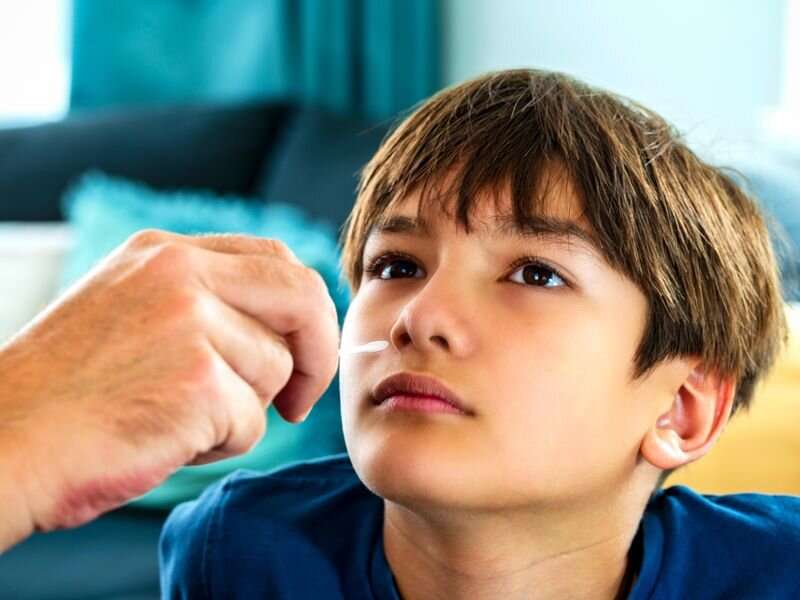This article has been reviewed according to Science X's editorial process and policies. Editors have highlighted the following attributes while ensuring the content's credibility:
fact-checked
peer-reviewed publication
reputable news agency
proofread
1 in 5 kids had long COVID symptoms months after infection

Close to one-fifth of kids with COVID-19 may still have lingering symptoms months after their initial infection, new research finds.
The review, of 31 international studies, found that over 16% of children and teenagers with COVID had problems such as sore throat, persistent fevers, fatigue and muscle weakness at least three months later.
Experts said the findings add to a still-evolving picture of how COVID affects kids in the longer term.
What is clear, they said, is that children can develop long COVID, and it is far from a rare occurrence.
"This is not a trivial infection," said senior researcher Zulfiqar Bhutta, co-director of the Centre for Global Child Health at the Hospital for Sick Children in Toronto. "We need to take it seriously."
He and his colleagues report the findings in Pediatrics.
More than three years after the start of the pandemic, long COVID remains something of a mystery—and its effects on kids are no exception.
But studies are ongoing, said Dr. Melissa Stockwell, division chief of child and adolescent health at Columbia University Vagelos College of Physicians and Surgeons in New York City.
Stockwell and colleagues at Columbia are part of a large national study called RECOVER, funded by the U.S. National Institutes of Health, which is aimed at better understanding the long-term effects of COVID in adults and children.
Stockwell said that while it's hard to say exactly what percentage of kids develop long COVID, the evidence suggests it's between 10% and 20%. So the new findings align with that, she said.
"It's really worrisome, because that's a very large number of kids," Stockwell said.
Yet, she noted, "I don't think most people even know that kids get long COVID."
Researchers are still trying to understand the underlying biology of long COVID—whether symptoms are driven by persistent virus in the body, an immune system on overdrive, or a combination of reasons. And it's unclear why some children, and not others, are affected.
There does seem to be a correlation between COVID severity and the risk of long-term symptoms, according to Stockwell: Kids who are more severely ill with the infection are at greater risk. But, she said, children with mild infections, or even no symptoms at all, can and do develop long COVID.
For the current review, Bhutta's team analyzed 31 studies published between December 2019 and December 2022, involving more than 15,000 children and teenagers with confirmed COVID infections. Some studies focused on kids who were ill enough to be hospitalized, but most included those who were sick at home.
Overall, just over 16% of kids had symptoms three months or more after their COVID diagnosis—including problems that had persisted since the infection or newly arose in the weeks to months afterward.
The most common symptoms, Bhutta's team found, were persistent sore throat and fevers, fatigue, sleep problems and muscle weakness. But kids—like adults with long COVID—also had an array of other issues, including headaches, shortness of breath and gastrointestinal symptoms like diarrhea and abdominal pain.
At this point, Stockwell said, management of long COVID is aimed at easing the particular symptoms a child has.
For those kids, and their parents, a major question is, how long will this last? Researchers are still studying the typical course of long COVID. But based on what's known, Bhutta said, at least a portion of kids do get better six to 12 months out.
As for what parents can do to protect their kids, it's not yet clear whether COVID vaccination
curbs the risk of long COVID should a child become infected.
"But," Stockwell said, "we do know that vaccination lowers the risk of severe COVID."
That alone is good reason to have your kids vaccinated and up to date on their boosters, Bhutta and Stockwell said.
Bhutta also pointed to another major knowledge gap: the lack of studies from middle- and low-income countries. In those countries, with limited access to vaccines and treatments, the prevalence of long COVID among children could actually be higher, Bhutta said.
More information: Li Jiang et al, A Systematic Review of Persistent Clinical Features After SARS-CoV-2 in the Pediatric Population, Pediatrics (2023). DOI: 10.1542/peds.2022-060351
Copyright © 2023 HealthDay. All rights reserved.


















